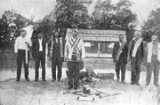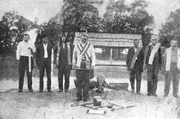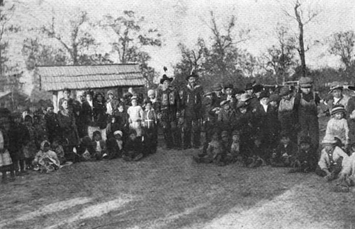
Keetoowah Nighthawk Society
Encyclopedia

Keetoowah
The Cherokee believe the ancient settlement of Kituwa or giduwa , on the Tuckasegee River is their original settlement and is one of the "seven mother towns" in the Southeast...
, in present-day North Carolina.
Etymology
The word "Keetoowah" is the name of an ancient Cherokee Township in the Eastern Homeland of the Cherokee, where all Cherokee originated after the migration and integration of various groups from the Great Lakes and Ozark Plateau Regions of the United States 3,000 years ago, based upon cultural and archaeological evidence. There is also evidence in the modern culture to suggest that the ancient Keetoowah developed an ancient hereditary priesthood called the Ah-ni-ku-ta-ni, who were a religious ruling class of the Keetoowah people and Cherokee Society for thousands of years.According to Cherokee legend, when the population grew too large to sustain the Mother city, groups moved to new areas and created new Cherokee Communities and Mound Cities. The residents of the city of Keetoowah called themselves "the Keetoowah People". The ancient site of the Mother City of Keetoowah is still visible in Western North Carolina in the same general area as the Qualla Boundary
Qualla Boundary
The Qualla Boundary is the territory where the Eastern Band of Cherokee Indians reside in western North Carolina.-Location:...
. Keetoowah was an ancient "Mound" city and the central earthwork mound
Mound
A mound is a general term for an artificial heaped pile of earth, gravel, sand, rocks, or debris. The most common use is in reference to natural earthen formation such as hills and mountains, particularly if they appear artificial. The term may also be applied to any rounded area of topographically...
is still visible at the ancient townsite. Moundbuilding was not confined to the Cherokee, but was a common construction method of various Mississippian cultures and earlier peoples for thousands of years throughout the Mississippi Basin.
Some Cherokee traditionalists refer to themselves as Ah-ni-ki-tu-wa-gi (spelled variously in local Oklahoma dialects as Ki-tu-wa or Gi-du-wa), Keetoowah People. The addition of the verb stem modifier "gi" indicates the word Ki-tu'-wa-gi means, "a gathering or putting together of the Ki-tu'-wa people", since "gi" means "to combine" in the Cherokee Language. Most modern Cherokee speakers can no longer translate the word "Ki-tu-wa," as the meaning of the word has been lost. Ki-tu-wa means "the mother city" or "the center (spiritual center)" in the ancient Ah-ni-ku-ta-ni dialect. The word Ki-tu'-wa-gi, implies a religious or social gathering of the people. Honoring the mother city was analogous to honoring Selu
Selu
SELU or selu may refer to:* Southeastern Louisiana University* Cherokee mythology for maize...
, the Cherokee Corn Mother of the ancient Green Corn Ceremony
Green Corn Ceremony
The Green Corn Ceremony is an English term that refers to a general religious and social theme celebrated by a number of American Indian peoples of the Eastern Woodlands and the Southeastern tribes...
, a concept that pervades Cherokee culture.
During the Green Corn Ceremony
Green Corn Ceremony
The Green Corn Ceremony is an English term that refers to a general religious and social theme celebrated by a number of American Indian peoples of the Eastern Woodlands and the Southeastern tribes...
as practiced by the Cherokee, one of the two social dances performed is of ancient origin, and originated from the mother city of Keetoowah. The dance is called ye-lu-le which means "to the center". During this dance, all of the dancers shout ye-lu-le and move towards the fire in the center of the sacred dance circle . The dance symbolizes the dispersal of the sacred fire given to the Keetoowah people by the Creator and the Thunder Beings in their ancient legends. During traditional Green Corn ceremonies, the Cherokee carried the coals of the central fire in Keetoowah to all the Cherokee communities; the coals were used to kindle the ceremonial fires for the dances in each Cherokee City or township. The home fires in outlying Cherokee communities were extiguished before the ceremonies and re-lit from the coals of the fire kindled during the Green Corn dances.
History

Cherokee Nation (19th century)
The Cherokee Nation of the 19th century —an historic entity —was a legal, autonomous, tribal government in North America existing from 1794–1906. Often referred to simply as The Nation by its inhabitants, it should not be confused with what is known today as the "modern" Cherokee Nation...
was divided by the Dawes Commission
Dawes Commission
The American Dawes Commission, named for its first chairman Henry L. Dawes, was authorized under a rider to an Indian Office appropriation bill, March 3, 1893...
in the 1890s. The Dawes commission was tasked to force assimilation and breakup of tribal governments within Oklahoma by instilling the concept of land ownership among individual households of the Five Civilized Tribes
Five Civilized Tribes
The Five Civilized Tribes were the five Native American nations—the Cherokee, Chickasaw, Choctaw, Creek, and Seminole—that were considered civilized by Anglo-European settlers during the colonial and early federal period because they adopted many of the colonists' customs and had generally good...
. The commission divided large sections of land into household allotments to eliminate the traditional governments of the Cherokee and other tribes, which were based on communal holding of land. As a consequence of the Dawes Commission programs, the Cherokee culture and society was destabilized and strictly controlled. The federal government appointed chiefs of the tribe, who were reduced to administrators and carried out government programs intended to force assimilation of the Cherokee.
As part of assimilation, during the late 19th and early 20th centuries, the government sponsored Indian boarding schools, where Cherokee and other Native American children attended away from their families. They were prohibited from speaking their own languages or practicing their own religions and cultures. Over time, much of the Cherokee culture was lost. The remaining Cherokee during this period in history begin to adopt and integrate cultural practices of other tribes who were being forcibly removed into Oklahoma Territory.
To resist the cultural erosion, many Cherokee leaders and elders formed a secret society, the Keetoowah Nighthawk Society, where they secretly practiced the traditional ceremonies and gatherings. This group preserved much of the pre-removal culture, ceremonies, and beliefs of the Cherokee. In modern times, the society is fractured and is not affiliated with any particular Cherokee Nation, Band, or Tribe. Members of the fragments of the original society are affiliated with many Cherokee groups in Oklahoma. Many of the modern groups claiming to represent the original Keetoowah culture have integrated Christianity and various new age beliefs into their religious practices.
Redbird Smith

Redbird Smith
Redbird Smith was a Cherokee traditionalist and political activist. He helped found the Nighthawk Keetoowah Society, who revitalized traditional spirituality among Cherokees from the mid-19th century to the early 20th century.-Background:...
was an influential Nighthawk member who revitalized traditional spirituality among Cherokees, beginning in the late 19th century.
Redbird Smith was born July 19th, 1850 near the city of Fort Smith, Arkansas. His mother and father were with other Cherokee travelling to the Indian Territory from Georgia. His father, Pig Redbird Smith, was a devoted supporter of the Long House’s group of eastern Indians’ ancient rituals, customs and practices. His mother, Lizzie Hildebrand Smith, was from a prominent Cherokee family. During Redbird’s childhood, his father committed him to the service of the Cherokee people in harmony with the ancient customs, and eventually he became chairman of the council.
In 1889 the Redbird Movement began, splitting from Keetoowah to create Keetoowah Nighthawk. This renewed and modernized Keetoowah Society was more political, and held meetings at stomp grounds, or gatiyo, which are ceremonial areas. Descendants of the late chief John Ross
John Ross
-Australia:* John Ross , explorer of Central Australia* John Ross , member of the New South Wales Legislative Assembly...
reintroduced Cherokee wampum
Wampum
Wampum are traditional, sacred shell beads of the Eastern Woodlands tribes of the indigenous people of North America. Wampum include the white shell beads fashioned from the North Atlantic channeled whelk shell; and the white and purple beads made from the quahog, or Western North Atlantic...
belts to the Keetoowah. Although the Keetoowah Nighthawks were unsuccessful in forestalling the allotment of communcal lands, they strongly opposed the new program. allotment of the Cherokee tribal lands, that the government had agreed to do, with much passion.
In 1908, the Keetoowah Nighthawk Council held an election. As a result, Redbird Smith was chosen as chief and was known as the leader of the Keetoowah Nighthawk Society.
His goal was to retain all that was lost from the Keetoowah. He was eventually jailed, along with some followers, for resistance to the land allotment and registration of tribal members. Smith died in 1918, along with the movement, but the society has been revived by the Cherokee in Oklahoma. The seven ceremonial dance grounds in Oklahoma belong either to the Keetoowah tradition or the Four Mothers Society
Four Mothers Society
The Four Mothers Society is a religious, political, and traditionalist organization of Muscogee Creek, Cherokee, Choctaw and Chickasaw people, as well as the Natchez people enrolled in these tribes, in Oklahoma. It was formed as an opposition movement to the allotment policies of the Dawes...
. In Redbird Smith's time, there were more than 20 Cherokee Stomp Grounds.
Redbird Smith (Great Grandfather of Chadwick "Corntassel" Smith, current Principal Chief of the Cherokee Nation of Oklahoma) stated in the early 1900s:
- "I have always believed that the Great Creator had a great design for my people, the Cherokees. I have been taught that from my childhood up and now in my mature manhood I recognize it as a great truth. Our forces have been dissipated by the external forces, perhaps it has been just a training, but we must now get together as a race and render our contribution to mankind. We are endowed with intelligence, we are industrious, we are loyal and we are spiritual but we are overlooking the Cherokee mission on earth, for no man nor race is endowed with these qualifications without a designed purpose... Our pride in our ancestral heritage is our great incentive for handing something worth while to our posterity. It is this pride in ancestry that makes men strong and loyal for their principal in life. It is this same pride that makes men give up their all for their Government."
In media
The 1984 KJRH-TV documentaryTelevision documentary
Documentary television is a genre of television programming that broadcasts documentaries.* Documentary television series, a television series which is made up of documentary episodes....
, Spirit of the Fire documented the history of the Keetoowah Nighthawk Society. It recounts their preservation of the traditional ceremonies and rituals practiced and maintained by the early Oklahoma Cherokee people.

